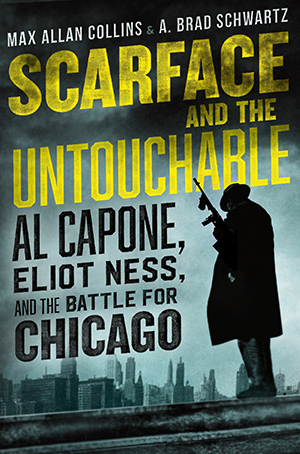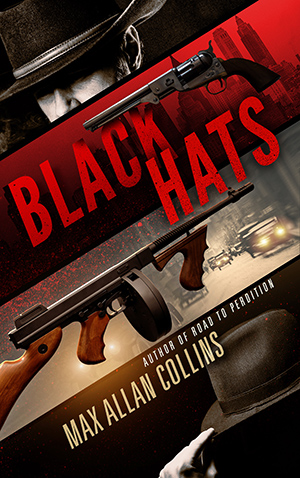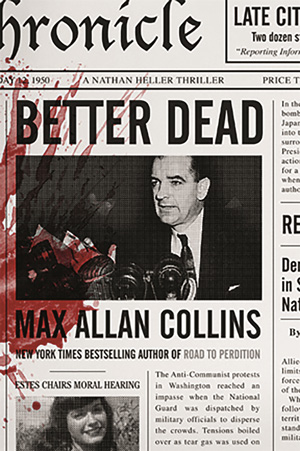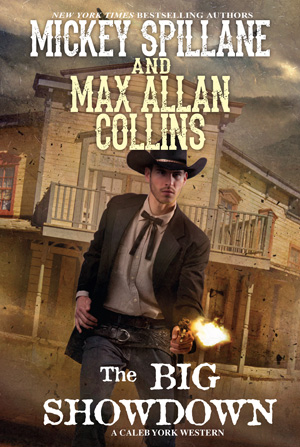It’s very encouraging to see the positive reader and reviewer response to the two newest books of mine, Shoot-Out at Sugar Creek and Skim Deep. Right out of the gate, however, Skim Deep received an absolutely terrible Publisher’s Weekly review, and I wondered if I’d delivered a bomb; but every review since has been stellar, like this one from Steve Steinbock in the new Ellery Queen’s Mystery Magazine:
And thus far the reader response has been glowing, too. Shoot-out at Sugar Creek is also getting raves from readers. This is from Dave at GoodReads:
A bunch of other five-star reviews follow, some of the best I’ve ever received at GoodReads.
So why am I splashing around in all this praise raining down on me? Because it shows the ironies of the working writer’s life. Kensington cancels Caleb York and I immediately get more praise for it than any other book in the series. I write one last book (Skim Deep) about Nolan, who I created around 1968 and who was first in print in 1972, and suddenly people love him just when I’ve determined not to write about him anymore.
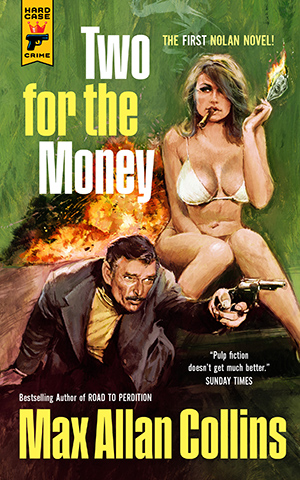
Well, you never know with me. I have a habit of coming back to characters – Quarry a prime example – after they have supposedly run their course. I’ve started thinking about a possible Quarry/Nolan crossover novel already. And thanks to Charles Ardai and Hard Case Crime, the existing Nolans are all coming back out in two-to-novels-to-one-book format. A new edition of Two for the Money (collecting the first two Nolans, Bait Money and Blood Money) is available now. Such a deal.
And Wolfpack has expressed interest in continuing Caleb York, but – as I mentioned last week – I am booked up into early next year, so that’s a decision that’s on hold.
Here’s Bill Ott’s Booklist review of today about my yesterday books.
By Max Allan Collins
May 2021. Hard Case Crime, paper, $14.95
The reappearance of Collins’ first series hero, superthief Nolan, in Skim Deep (2020) was an unexpected treat for the author’s fans, but it was only the first course. Now Hard Case Crime is reissuing all of the long-out-of-print Nolan novels. This volume brings together the original Nolan adventure, Bait Money, along with its sequel Blood Money. Originally conceived as a one-off homage to Donald E. Westlake’s Parker, Nolan immediately stood on his own legs, and, with Westlake’s blessing, Collins went on to give the aging thief, tough as they come but longing to get out of the game, extended life through seven novels published in the ’70s and ’80s. These first two hold up just fine, thanks to Collins’ ability to create indelible characters in a few brushstrokes and to construct plots that are just twisty enough to work. Bait Money finds Nolan, nearing 50 with gray hairs sprouting, forced to take on a bank job with a trio of headstrong youngsters. Naturally, it goes bad, leading to the revenge plot in Blood Money. An old-school pulpy pleasure, but with plenty of meat on its bones.
Despite (or perhaps because of) all this praise, I find myself reflecting on the ephemeral nature of writing popular fiction (not that all the fiction I write is particularly popular). I have been mulling of late the fate of F. Hugh Herbert, who has become a favorite writer of mine. And now, for those of you who have waded through all this shameless self-promotion and yay-me applause, I am about to subject you to something that will strike many of you as ridiculously obscure even for me.
Last year, when I began working on the first of the three Fancy Anders novellas for Neo-Text (more news about them soon), I gathered research about the WW 2 home-front in general and Los Angeles in particular. My main focus was on female defense plant workers and the Rosie the Riveter phenomenon. I encountered a wonderful book called Slacks and Calluses (1944) by two teachers, writer Constance Reid and illustrator Clara Marie Allen, a memoir of a summer vacation working at an aircraft plant. It’s a terrific, funny, insightful book and still in print.
I loved it so much I sprang for an original edition in dustjacket signed by the authors, including a Clara Marie Allen drawing. The co-authors went onto distinguished careers in writing and art respectively.
I also picked up, to get some flavor of wartime America and particularly a feel for a young woman of the times, the book Meet Corliss Archer (1944). A handful of you will be pop culture junkies enough to remember Corliss Archer, once a household-name character who began in a series of Good Housekeeping short stories that were gathered loosely into a sort of novel called, yup, Meet Corliss Archer.
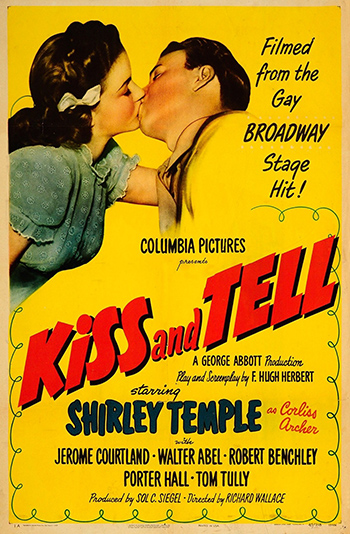
The character was part of an era that produced Andy Hardy, Henry Aldrich, and Archie and his gang, but of course the focus was on a teenage girl. I found the book charming and funny and a snapshot of the era, featuring wonderfully forgotten slang and very interesting attitudes of the day. The Corliss Archer stories became a huge hit Broadway show, Kiss and Tell (1945), and later a film starring a “grown-up” Shirley Temple, followed by a sequel, A Kiss for Corliss (1949). A radio show ran from January 7, 1943, to September 30, 1956, and there were briefly comic strips and comic books (drawn by EC’s Jack Kamen and Al Feldstein) about Corliss, her boyfriend Dexter, her parents and others. The radio show’s most famous Corliss was Janet Waldo, who was the voice of Judy Jetson on, well, The Jetsons. TV versions of Kiss and Tell played live in the early ‘50s, followed by a not very good Meet Corliss Archer TV series.
Creator F. Hugh Herbert had little if anything to do with the TV series, but he was apparently somewhat hands on with the radio show. He wrote the screenplay for the film of Kiss and Tell but not the not-so-good sequel.
Herbert isn’t the “woo woo” comedian, by the way, despite what some Internet sources may tell you. But he was an enormously successful playwright and screenwriter. His play The Moon Is Blue (1951) is infamous for the Otto Preminger film version (1953) going out without the Production Code seal. It was mildly racy by today’s standards, but the word “virgin” was a big no-no in movies then, and in Blue it was uttered several shocking times on screen.
Herbert was very good at racy dialogue, and actually dialogue in general. His screenplays include Dark Command, Margie, Sitting Pretty, Home Sweet Homicide and Let’s Make It Legal. He wrote and directed a few films, including Scudda Hoo! Scudda Hay! (in which Marilyn Monroe spoke her first screen line).
Herbert began in silent films when a novel of his, There You Are! (1925), attracted Hollywood attention. While his plays generated a number of Broadway hits, his novels attracted little notice (except for Meet Corliss Archer). He only wrote a handful – five that I know of. I’ve located all of ‘em (no small trick) with only the first 1920s-era novel left to go. I’ve read most of his plays, as well.
Look, I get on a “kick” every now and then. Somebody’s work interests me and I start tugging on loose strings in search of a sweater. I can only say I like F. Hugh Herbert’s work. He would probably get into trouble today because he liked to explore (long before Lolita) the attraction between young women and older men. Margie, a very popular film considered a harmless 1946 piece of fluff about the 1920s, is about a teenage girl going to the prom with her male French teacher (who in a postscript we discover she married).
Herbert was, in his way, pushing the sexual envelope in the 1940s and ‘50s. Kiss and Tell revolves around Corliss Archer’s parents thinking Corliss is pregnant by a soldier on leave – not something you’d find in Andy Hardy or Henry Aldrich, and I’m pretty sure Archie never got Betty or Veronica in the family way.
The Moon Is Blue was notorious for its sexual content, however innocuous it now seems. The dialogue remains witty.
His novel A Lover Would Be Nice (1935) is about a shallow young woman who marries a nice if somewhat boring young man and ponders whether an affair would improve things; the conclusion is surprisingly adult. The Revolt of Henry (1937), a wonderfully written novel, is about a henpecked personnel man at a department store whose wife is casually cruel and takes Henry to the brink of murder. Henry has an affair with a younger woman, of course, and the ramifications are also surprisingly adult and modern in what essentially is a James M. Cain novel that somehow doesn’t result in homicide and/or prison. Herbert’s final novel, I’d Rather Be Kissed (1954), rather shamelessly reboots Corliss Archer but changes her name and everyone else’s, though the cast is otherwise identical right down to the dumb family dog. He states on the dustjacket that he’s been inspired by J.D. Salinger’s Catcher in the Rye to take things up a level. And he does, brilliantly.
He died shortly thereafter at age 61.
I am not recommending these books. You might find them too dated or the young woman/older man aspect creepy. And you might be right. But I liked Herbert’s artistry and craft, and his sort-of-novel Meet Corliss Archer was very helpful to me in creating Fancy Anders.
But mainly I’m not recommending his novels because you won’t be able to find them, except perhaps Meet Corliss Archer in a reprint edition or a first edition sans dust jacket (you don’t want to know what my copy of the latter cost me in dust jacket) (or anyway Barb doesn’t). And that’s my point.
F. Hugh Herbert was once a famous author and playwright responsible for two major pop culture creations (Corliss Archer and The Moon Is Blue). You likely never heard of him. You can see a good number of the movies he wrote, and probably already have, but his novels are gone. As if they never existed.
The ephemeral nature of what his accomplishments add up to troubles me. I mean, I already knew the sun was going to burn up someday, but I was kind of hoping my body of work would last till then, in some form.
Many of the authors I really admire are either forgotten or on their way to obscurity – Calder Willingham, William March, Mark Harris.
What that leaves, in all this, is you – those of you still out there reading, and the ones reading my work please know…I am grateful.
Let’s wind up with this delightful review of Quarry’s List by someone who has read a lot of my stuff and really seems to get it.
M.A.C.
